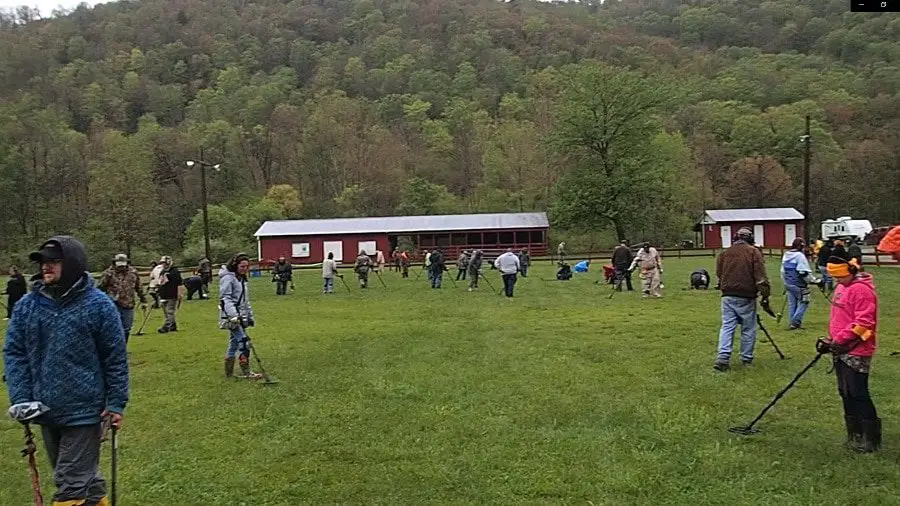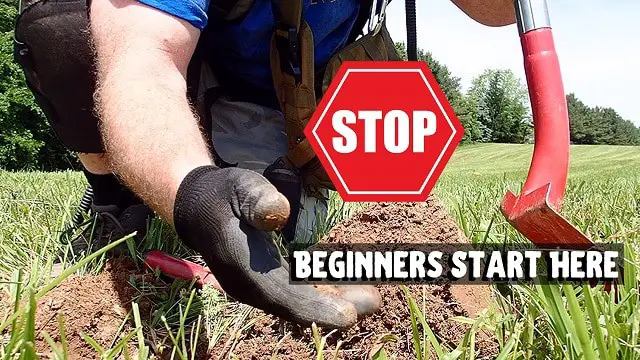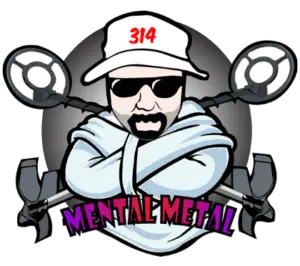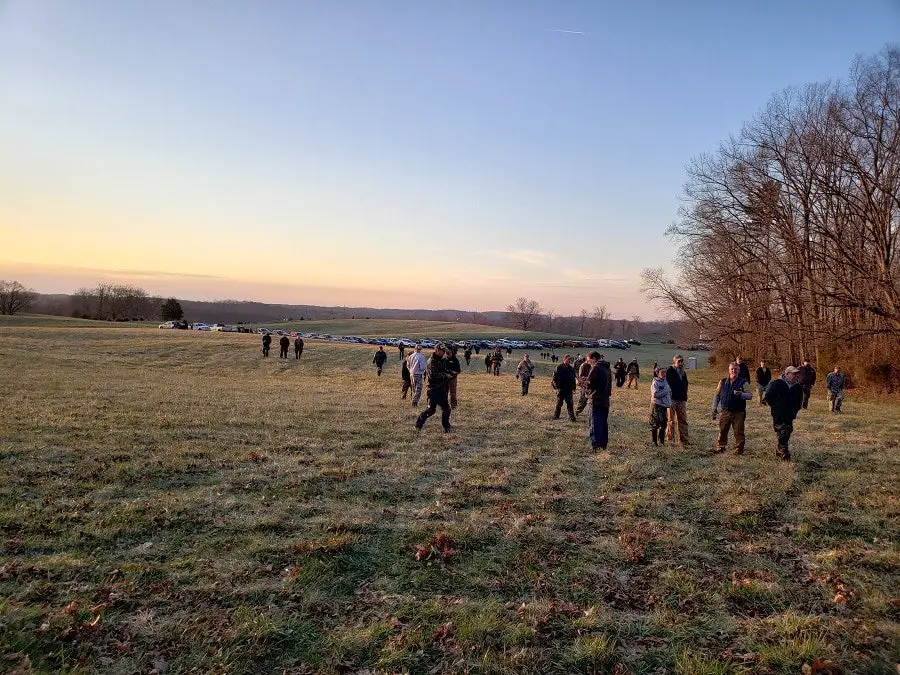Paid metal detecting hunts are metal detecting events you pay money for the opportunity or invitation to hunt on a special site or in some cases where something significant happened. The participant pays a fee to metal detect within the rules and boundaries set forth by the organizers of the event.
There are two types of paid metal detecting hunts.
- Seeded Metal Detecting Hunts
- Natural or Non-Seeded Metal Detecting Hunts
But whats the difference? This articles goes over both types of paid hunts, how you should hunt them, and what you can expect from each of them.
Natural or Non-Seeded Metal Detecting Hunts.
I have personally participated in many “Natural” or non-seeded paid hunts in Virginia also know as DIV hunts. DIV stands for “Digging In Virginia”. DIV events are held on private permissions where some type of activity from the American Civil War took place. Usually DIV events take place at locations known to have been winter encampments to both Union and Confederate soldiers during the winter months of the civil war. But they have also taken place at or near major battle sites that took place during the civil war.

These hunts are not seeded. They are considered natural hunts. The relics you find have been in the ground for over 150 years. If you are a American Civil War enthusiast and you love hunting for civil war relics, DIV events are something to consider. They are tough hunts and you’ll earn what you find. But you will also learn a lot about the relic hunting, meet a lot of new people, see a lot of amazing finds, and make some lifelong friends.
There are other types of natural or “non-seeded” hunts. Probably one of the most popular in 2019 was Pound The Ground. This event took place on over 1200 acres. A portion of this hunt was seeded but the majority of even was mostly a natural hunt. You were allowed to roam the permission, hunt freely, and keep what you find. This hunt probably drew the biggest crowd of metal detector enthusiasts in the United States in 2019.
In Europe they also have similar hunts but many times you will hear them referred to as metal detecting rallies. I have not personally attended one of these events but the same idea applies. Many of them are seeded but a lot of them are not.
How to Hunt a Natural or Non-Seeded Site?
Every site has information about that everyone wants to know such as; where were the house sites, human activity, etc.? But that information may or may not be shared. If it isn’t you can bet that there is someone associated with the site or with the organizers who know where to go. It might be worth rubbing shoulders with them and to obtain as much information as you can. It just might make or break your experience. If you can’t find out this information, I recommend the following:
- Watch where the majority of the people go as the hunt begins. You can almost bet your last dollar that someone has some inside information. Follow them.
- Hunt the places most folks won’t such as thick brush, wooded areas, near streams. Most people will stay in open fields where its easier to swing their coil. I recommend taking a smaller coil to hunt the areas others won’t.
- A lot of people run away from heavy iron patches. Don’t! This is a good indication that something took place. Slow down and listen for those squeaks. Yes you will dig a bunch of nails but you could also be rewarded with a coin, button, or better GOLD!
- Look for pieces of brick or pottery. If you starting seeing these items slow down you could be near the house site.
- If you start running into mason jar lids, pieces of tin, etc. This could be a trash pit. Dig it out.
What to Expect From Natural or Non-Seeded Hunts.
- They usually take place over wide areas (many acres of land).
- You keep what you find (usually).
- There are no guarantees. You may not find anything.
- Stay hydrated. Drink plenty of water throughout your hunt.
- Depending on how far away you are from where you start, take food to munch on.
- Take toilet paper. You should never leave home without it!
- Write down or know the how to contact the emergency medial team (EMTs) if you or someone else has a medical condition who may need help.
- Take a pain killer. For multiple day hunts, plan on being sore after the first day. You will use muscles your body forgot you had.
- There will be folks who find amazing things. This is the norm. The majority of participants won’t find much. This is the norm.
- Most of time, these hunts are not on virgin ground and have been hunted before.
Seeded Metal Detecting Hunts.
If you are looking to come home with something in your treasure pouch then seeded metal detecting hunts are for you. I have attended many seeded hunts over the years and most of them are similar but differ in the type of hunts that are held during in the event.

For instance, most seeded hunts will scatter pennies, prize tokens, coins, silver coins, jewelry, and other metal objects within a boundary that is designated by the organizers. Usually, there will be at least 3-4 of these boundaries set up for each of the scheduled hunts. The hunts are usually completed within a time limit. Once the time is up, each person checks theirs finds pouch for prize tokens etc. and retrieves their prizes from the event organizers. Sometimes, sponsors of the event will be giving away metal detectors and their might be something specific buried to find that will win you that detector. At some of the events I’ve attended, the organizers buried keys and if you found the key that opened a specific lock for the detector they were giving away, then you won the detector.
How to Hunt a Seeded Metal Detecting Event.
Usually these hunts are timed and may last from 30-60 minutes depending on the size of the location. Before the hunt begins, the organizers will usually line you up on the edge of the hunt boundary. Once the hunt kicks off, you will see most people gravitate to the middle of the hunt area at the very beginning. I have no idea why this happens. Within the first 15 minutes I always focus on the outer edge of the hunt area because everyone leaves it. You have 15 minutes to scarf up what others ran over so hurry!
After the first 15 mins, I start walking in a grid pattern, up and down, side to side until you cover most of the hunt area. You will probably want to pick up the pace a bit to cover the area. Control your swing and cover as much area as you can. Its amazing what folks walk over when they are running past you.
Don’t waste your time on targets that sound deeper than the rest. These targets are probably not part of the seeded hunt. Yes, you can dig them but you are wasting valuable time when you could be picking up 5 more targets from the seeded hunt and some of them could be prizes!
What to Expect From Seeded Hunts.
- One of the biggest problems many folks experience at seeded hunts is interference from other machines. One of the most common machines at these events (today) is the Garrett AT Pro. When 60+ people show up at these events with the same machine you will hear a lot of complaining. I’ve witnessed a lot of folks bring their older machines (not on the market anymore) because they don’t interfere with the newer machines. It is something to consider.
- You don’t need a high end machine for these events. Most of the items are barely below the surface. Most machines will pick up those shallow targets.
- Expect crowed hunt areas. This is the norm.
- Expect folks to be running past you. This is the norm. You will see folks literally running around with their machine. I really don’t understand why they think they need to move so fast but they do. This is the norm and sometimes annoying but comes with the territory.
Conclusion
Both types of paid metal detecting hunts are a lot fun and enjoyable. If you have never attended one of these hunts you should. You will learn a lot at one of these events and you’ll meet new enthusiasts who are just as passionate about the metal detecting hobby as you are. Plus, you have the opportunity uncover something truly special or win a really nice prize. I highly recommend attending them.
Are You New to Metal Detecting?
If you are then you should probably check out this section of the website titled “For Beginners“. It is packed pull of information that will help you get started. Plus, I share many secrets that other websites won’t. Check it out now.


